Climate change 'did not force Vikings to abandon Greenland in 15th century'
Geologists have all but ruled out claims the Medieval Warm Period accounts for Greenland's colonisation from 986AD

Your support helps us to tell the story
From reproductive rights to climate change to Big Tech, The Independent is on the ground when the story is developing. Whether it's investigating the financials of Elon Musk's pro-Trump PAC or producing our latest documentary, 'The A Word', which shines a light on the American women fighting for reproductive rights, we know how important it is to parse out the facts from the messaging.
At such a critical moment in US history, we need reporters on the ground. Your donation allows us to keep sending journalists to speak to both sides of the story.
The Independent is trusted by Americans across the entire political spectrum. And unlike many other quality news outlets, we choose not to lock Americans out of our reporting and analysis with paywalls. We believe quality journalism should be available to everyone, paid for by those who can afford it.
Your support makes all the difference.Climate change is blamed for many things in history, but it seems that it can now be ruled out as an explanation for why the Vikings had abandoned their settlements in Greenland by the mid-15th Century after 400 years of valiant occupation.
Some historians have suggested that the Medieval Warm Period, when vines were grown as far north as York, can account for the colonisation of southern Greenland by Vikings sailing in ice-free waters from their earlier settlements on Iceland, starting in 986AD.
Equally, the rather abrupt abandoment of Greenland some four centuries later was rather neatly explained by the start of the so-called Little Ice Age, which was estimated to have run between about 1350 to 1850 and is said to have been why it was possible to have frost fairs on a frozen River Thames.
However, geologists who have analysed the rocky “moraines” left behind by retreating glaciers in Greenland and nearby Baffin Island, where Vikings were also thought to have settled, have all but ruled out changes in the local climate as the reason for the colonisation and abandoment of this most westerly outpost of the Viking empire.
“We have found no reason to believe that it was any more warmer at the start of the colonisation than at the end. It looks like the climate was by and large pretty stable. Other factors must have led to them leaving Greenland,” said Nicolas Young, a glacial geologsit at Columbia University’s Lamont-Doherty Earth Observatory in New York.

There is little doubt that the Medieval Warm Period did exist, although scientists have disputed the dates it began and ended. But there is mounting evidence that it was largely a European phenenomon and related to the “sea-saw” oscillation of the North Atlantic climate – when western Europe is warm, southern Greenland becomes cooler, and vice versa, Dr Young said.
“It’s becoming clearer that the Medieval Warm Period was patchy, not global. The concept is Eurocentric [because] that’s where the best known observations were made. Elsewhere, the climate might not have been the same,” Dr Young explained.
“Our study suggests that when the Greenland Norse arrived, it was at least as cold as when they left some 400 years later. If the Vikings travelled to Greenland when it was cool, it’s a stretch to say deteriorating climate drove them out,” he said.
The red-bearded Viking Erik the Red was first to colonise southern Greenland, which he allegedly named as a propaganda exercise to encourage other Icelandic Vikings to follow him. The colonisers brought sheep and cattle and established farms on the few unglaciated pastures.
They built about 400 stone buildings, including churches, a monestery and even a cathedral with an imported bronze bell and green-tinted glass windows, trading for several generations in polar bear skins, narwhal tusks and walruss ivory with the fellow Norse speakers in Iceland and Norway in return for iron tools and other essentials.
With a population that peaked at about 5,000 individuals, they were the most westerly-living Europeans for several centuries until Columbus discovered America, but something happened in the 15th Century that led them to abandon their remote settlements in the West and then East of southern Greenland.
“It was probably a combination of socio-economic factors such as the collapse of the market for walruss ivory. Whatever it was, it was probably not related to the climate, which must have been as harsh as it ever was,” Dr Young said.
Astrid Ogilvie, a climate historian at Iceland’s Akureyri University, said that the findings published in the journal Science Advances, show that the climate is clearly a more complicated factor than some people had assumed when it came to the Greeland Norse.
“I do not like the simplistic argument that the Greenland people went there when it was warm and then ‘it got cold and they died’. I think the Medieval Warm Period has been built on many false premises, but it still clings to the popular imagination,” Dr Ovilvie said.
Join our commenting forum
Join thought-provoking conversations, follow other Independent readers and see their replies
Comments